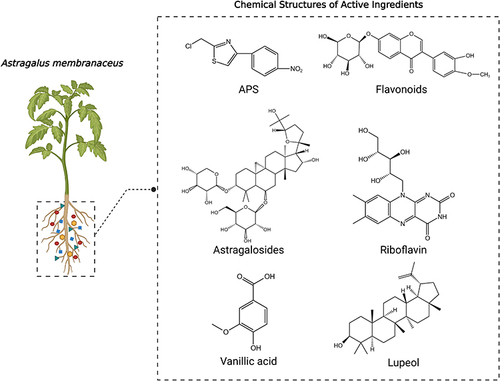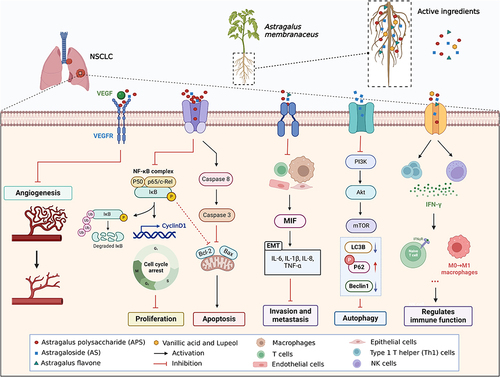Figures & data
Figure 1 Chemical structures of key active ingredients in Astragalus membranaceus. Depicted above are the chemical structures of various active ingredients extracted from Astragalus membranaceus, including Astragalus polysaccharides (APS), flavonoids, astragalosides, riboflavin, vanillic acid, and lupeol. These compounds are highlighted for their significant roles in pharmacological applications, contributing to the plant’s efficacy in traditional and modern medicine practices.

Figure 2 Pharmacological activity of Astragalus membranaceus in NSCLC. The diagram presents a comprehensive view of the antitumor effects exerted by Astragalus membranaceus against Non-Small Cell Lung Cancer (NSCLC). It highlights the plant’s active compounds - including Astragalus polysaccharide (APS), Astragaloside (AS), and Astragalus flavone - and their interactions with key cellular pathways. These compounds target and modulate multiple processes: they inhibit angiogenesis via VEGF and VEGFR signaling; they suppress tumor proliferation by downregulating the NF-κB pathway and CyclinD1 expression; they promote apoptosis through caspase activation and balancing Bcl-2/Bax proteins. Additionally, the diagram indicates the role of Astragalus membranaceus in immune regulation, enhancing the activity of Th1 cells and M1 macrophages, while reducing T cell suppression. It also illustrates the inhibition of autophagy, a process that may enhance the apoptosis of tumor cells, thus potentially serving as a beneficial therapeutic agent in the treatment of NSCLC.

Data Sharing Statement
Data sharing is not applicable to this article as no datasets were generated or analysed during the current study.
